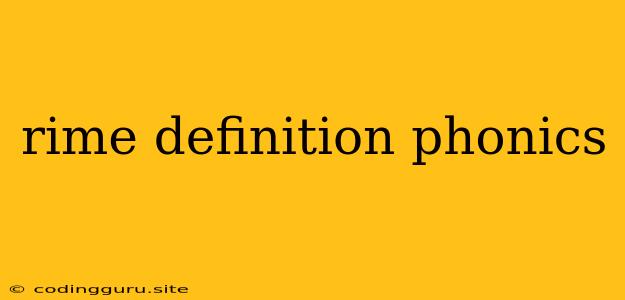What is a Rime and How Does it Relate to Phonics?
In the world of early literacy, understanding the concept of rime is crucial for both teachers and parents. Rime is a key component of phonics, a method of teaching reading by focusing on the relationships between letters and sounds. But what exactly is rime?
Rime refers to the part of a word that includes the vowel sound and all the sounds that follow it. Think of it like the "tail" of a word. For example, in the word "cat," the rime is "at."
Why is Rime important?
Rime plays a significant role in phonics because it helps children learn to recognize patterns in words. When children learn to identify a rime, they can use that knowledge to decode new words. For example, if a child knows the rime "at," they can easily recognize other words with the same rime like "bat," "mat," and "hat."
How can I use Rime in my phonics lessons?
There are many ways to teach rime to children. Here are some tips:
- Start with simple words: Begin by focusing on words with common rimes like "at," "an," "in," "ig," and "og."
- Use picture cards: Create picture cards that depict words with the same rime. For example, you could use cards with pictures of a cat, a bat, and a mat.
- Sing rhyming songs: Rhyming songs are a fun and engaging way to introduce rime to children.
- Read rhyming books: Choose books with repetitive rimes and encourage children to identify the rimes within the words.
- Play games: There are many phonics games that focus on rime. For example, you can play a memory matching game with cards that have words with the same rime.
Examples of Rimes
Here are some common rimes found in English words:
- at (cat, bat, hat, mat)
- an (can, fan, man, pan)
- in (pin, fin, tin, win)
- ig (pig, big, dig, fig)
- og (dog, log, fog, frog)
The Importance of Rime in Reading Development
The ability to recognize rimes is an important skill for reading development. When children can identify rimes, they can more easily:
- Decode new words: They can use their knowledge of rimes to sound out new words.
- Build fluency: They can read more quickly and smoothly because they can recognize words more easily.
- Improve comprehension: They can focus on the meaning of the text instead of struggling to decode individual words.
Conclusion
Rime is a fundamental concept in phonics that helps children learn to recognize patterns in words. By teaching children about rime, we can equip them with the skills they need to become successful readers. By using a variety of fun and engaging activities, we can make learning about rime enjoyable and meaningful for our young learners.
